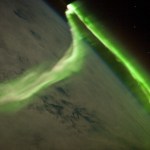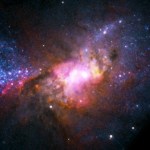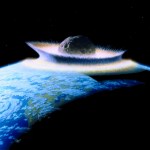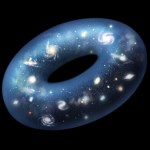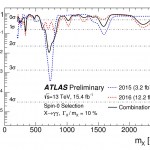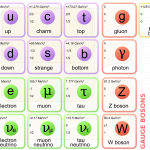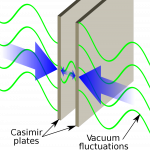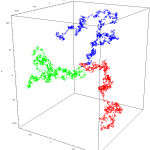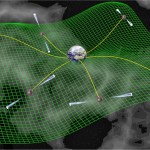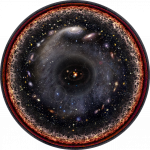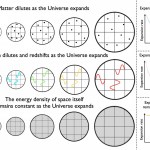Physics
“Concentrate all your thoughts upon the work at hand. The sun’s rays do not burn until brought to a focus.” -Alexander Graham Bell
In 1859, the Sun surprisingly increased in brightness so significantly for just a brief while that it was noticeable from Earth during the day. Less than 24 hours later, aurorae were visible so brightly and so far south that people awoke in the middle of the night, thinking it was dawn. But in addition to the spectacular sights, there were also downsides: telegraph wires spontaneously caught on fire, causing significant amounts of damage.
The atmospheric effects…
The Pale Red Dot project has found a planet.
It is a terrestrial planet, orbiting in the formal habitable zone of Proxima Centauri, the nearest star to the Solar System.
This wide-field image shows the Milky Way stretching across the southern sky. The beautiful Carina Nebula (NGC 3372) is seen at the right of the image glowing in red. It is within this spiral arm of our Milky Way that the bright star cluster NGC 3603 resides. At the centre of the image is the constellation of Crux (The Southern Cross). The bright yellow/white star at the left of the image is Alpha Centauri, in fact a system…
"For something to collapse, not all systems have to shut down. In most cases, just one system is enough." -Robert Kiyosaki
Do supermassive black holes form from the merger and growth of many smaller black holes, falling towards a cluster/galactic center where they find one another and grow into a behemoth? Or is there a direct-collapse mechanism at play, where a black hole thousands, tens of thousands or even hundreds of thousands of times the mass of our Sun forms spontaneously?
The X-ray and optical images of a small galaxy containing a black hole many tens of thousands of times the mass…
Several weeks of silence here, for a bunch of reasons that mostly boil down to "being crazy busy." I've got a bunch of physics posts over at Forbes during that interval, though:
-- The Camera Trick That Justifies The Giant Death Star: I busted out camera lenses and the kids' toys to show how you might make the Death Star appear as huge as on the Rogue One poster.
-- How Quantum Physics Could Protect You Against Embarrassing Email Hacks: Using the DNC email leak as an excuse to talk about quantum cryptography.
-- Four Things You Should Expect To Get Out Of College: Some advice for students…
“Honestly, if you're given the choice between Armageddon or tea, you don't say 'what kind of tea?” -Neil Gaiman
Enjoying the Perseid meteor shower this year, as perhaps you do every August? As you look up, the great cosmic show might have a lot more to offer than mere streaks of light, due to cometary debris brightly burning up in the Earth’s atmosphere. This year, Jupiter has slightly disturbed the debris stream, resulting in an increase in the number of meteors-per-hour, as the stream passes quite centrally through Earth’s location.
The orbital path of Comet Swift-Tuttle, which passes…
"For once you have tasted flight you will walk the earth with your eyes turned skywards, for there you have been and there you will long to return." -Leonardo da Vinci
The Universe is an awfully big place, but how certain are we that we couldn’t travel in a straight line for a very long time and simply return to our starting position? Just because we can travel through the Universe for an arbitrarily, perhaps infinitely long distance-or-time, doesn’t mean the Universe itself is infinite. It’s quite possible that it closes in on itself, and that any straight-line path will eventually return…
“The first principle is that you must not fool yourself, and you are the easiest person to fool.” -Richard Feynman
Like many suggestive signals in the past, the 750 GeV bump in the diphoton channel has turned out to be a mere phantasm: an unlikely statistical fluctuation that simply disappeared as more data was collected. While almost the entire particle physics community was hoping for a different outcome, this is apparently the Universe we were dealt.
The ATLAS and CMS diphoton bumps, displayed together, clearly correlating at ~750 GeV. Image credit: CERN, CMS/ATLAS collaborations, image…
"Resistance to the organized mass can be effected only by the man who is as well organized in his individuality as the mass itself." -Carl Jung
If you divide the matter we know into progressively smaller and smaller components, you’d find that atomic nuclei, made of protons and neutrons, compose the overwhelming majority of the mass we understand. But if you look inside each nucleon, you find that its constituents -- quarks and gluons -- account for less than 0.2% of their total mass.
The particles of the standard model, with masses (in MeV) in the upper right. A proton, made up of two up…
“Even though the future seems far away, it is actually beginning right now.” -Mattie Stepanek
It's been a fantastic week here at Starts With A Bang, where we've covered even more ground than normal! First off, for those of you not following me on SoundCloud, we've got a new science podcast out, on the last star in the Universe.
Have a listen and enjoy; that's all possible thanks to the generous donations of our Patreon supporters, as are the re-runs of each article, ad-free, on a 7-day delay over on Medium. Here were the new pieces of this past week:
Will the 'Great Attractor…
“Energy is liberated matter, matter is energy waiting to happen.” –Bill Bryson
When it comes to the Universe, you might think that energy really is only limited by rarity: get enough particles accelerated by enough supermassive, super-energetic sources, and it’s only a matter of time (and flux) before you get one that reaches any arbitrary energy threshold. After all, we’ve got no shortage of, say, supermassive black holes at the hearts of active galaxies.
Galaxy NGC 1275, as imaged by Hubble. Image credit: NASA, ESA, Hubble Heritage (STScI/AURA).
And yes, we do find cosmic rays…
"Another very good test some readers may want to look up... is the Casimir effect, where forces between metal plates in empty space are modified by the presence of virtual particles." -Gordon Kane
If you ask what the zero-point energy of space itself is, you can sum up all of the quantum fluctuations you can that arise in quantum field theory, and arrive at an absurd answer: 120 orders of magnitude greater than the observed. Yet if you assume that there’s an incredible cancellation and you get exactly zero, that removes the one thing our Universe needs to explain its expansion: dark energy.…
"Human beings are strong because we have the ability to change ourselves." Saitama, One Punch Man
The idea of stopping a meteor headed towards our planet with nothing but a superpowered human being sounds like a physical impossibility. But if you had a powerful enough, strong enough, fast enough human, it could be done, so long as you obeyed the laws of physics and conserved energy and momentum.
A map of the asteroid population by size. There are approximately a few million potential "10"s on the Torino scale, over 50 million potential "9"s and nearly a billion estimated potential "8"s…
"Dimension regulated the general scale of the work, so that the parts may all tell and be effective." -Vitruvius
In a four-dimensional Universe (3 space and 1 time), it’s easy to get lost. If you take a random walk, the chances of you coming back to your original starting point in a finite number of steps gets lower and lower the more dimensions you have. If all you could do was walk along a sheet of paper -- or even better, along the surface of a pipe -- you’d have a much greater chance of return than if you had all three spatial dimensions to deal with.
Isotropic random walk on the…
“Even though the future seems far away, it is actually beginning right now.” -Mattie Stepanek
After another tremendous week here at Starts With A Bang, including one where I recorded a new podcast (look for it later this week on SoundCloud), it's time to take a look back and review all that we've been through. From last Saturday through the past Friday, here's what we saw:
Are there different types of time and space? (for Ask Ethan),
Deepest view of the Orion nebula reveals shocking discoveries (for Mostly Mute Monday),
Forty years ago, we landed on Mars... and found…
“‘Star Trek’ says that it has not all happened, it has not all been discovered, that tomorrow can be as challenging and adventurous as any time man has ever lived.” –Gene Roddenberry
Today marks the 50th anniversary of the premiere of Star Trek, our first science fiction adventure that promised a positive view of the future, ushered in by technology and humanity's best traits. In addition to a utopia where maladies like hunger, disease and poverty were eradicated, Star Trek promised a future where technology was widely available and sufficiently advanced to the benefit of all of humanity…
"For me the best answer is not in words but in measurements." -Elena Aprile
If you want to find dark matter directly, your best hope is to gather a tremendous number of nucleons for it to interact with, wait an incredibly long period of time, and devise a device surrounding it capable of detecting even a single potential collision while distinguishing it from any background signals. That was the exact idea behind LUX, the Large Underground Xenon detector.
A diagram of the LUX detector. Image credit: LUX Collaboration, diagram by David Taylor, James White and Carlos Faham.
After a 20…
It's been a month since the last links dump of posts from Forbes, though, really, I took a couple of weeks off there, so it's been less than that in terms of active blogging time. But I've put up a bunch of stuff in July, so here are some links:
-- The Physics Of Ancient Roman Architecture: First of a couple posts inspired by our trip to Rome, this one looking at the basic mechanics of the key structural element of Roman building, the arch.
-- What Ancient Roman Buildings Teach Us About Science And Engineering: Second post about Roman construction, in which looking into the question of how…
"Go, then. There are other worlds than these." -Stephen King
We think of the Universe as all there ever is, was or will be. But, in fact, there's a limit to the most distant galaxies, stars, matter and radiation we can see. The hot Big Bang occurred a finite amount of time ago, and hence the amount of the Universe accessible to us through any observational means is necessarily limited.
Artist’s logarithmic scale conception of the observable universe. Image credit: Wikipedia user Pablo Carlos Budassi.
What lies beyond that? According to our best explanations and theories, there's more…
"If you're puzzled by what dark energy is, you're in good company." -Saul Perlmutter
The accelerated expansion of our Universe was one of the biggest surprise discoveries of all-time, and something that still lacks a good physical explanation. While many models of dark energy exist, it remains a completely phenomenological study: everything appears consistent with a cosmological constant, but nothing appears to be a good motivator for why the Universe should have one.
How energy density changes over time in a Universe dominated by matter (top), radiation (middle), and a cosmological constant…
“I found I could say things with color and shapes that I couldn’t say any other way — things I had no words for.” –Georgia O’Keeffe
The Standard Model is great at describing all the known particles we've ever observed and how they interact, but there are a number of important hints that it isn't all there is in the Universe. The existence of dark matter, dark energy, neutrino masses, the matter-antimatter asymmetry, the strong-CP and hierarchy problems all tell us that this collection of quarks, leptons, their antiparticles and the bosons we know are only part of the story.
The particles and…
